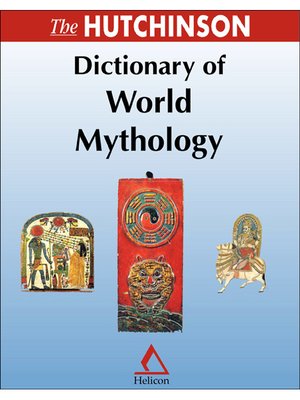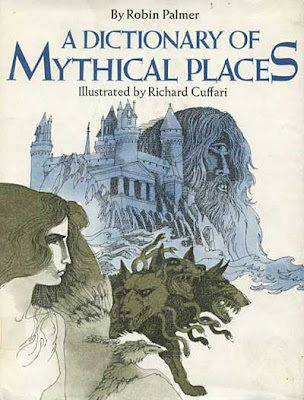
Enter a topic (for example "Egyption Gods") into the search box to see links to reference articles on the subject.

After reading an overview, use these sources to look up any unfamiliar terms.
 The Hutchinson Dictionary of World Mythology
This dictionary covers all the major myths, East and West, with entries on gods, goddesses, heroes, heroines, mythical creatures and episodes and other aspects of mythology, and shorter entries on many minor figures and places. Background information is provided in family trees, maps and charts.
The Hutchinson Dictionary of World Mythology
This dictionary covers all the major myths, East and West, with entries on gods, goddesses, heroes, heroines, mythical creatures and episodes and other aspects of mythology, and shorter entries on many minor figures and places. Background information is provided in family trees, maps and charts.
 Bloomsbury Dictionary of Myth
by
Kenneth McLeish; Kenneth Mcleish
This work retells the world's major myths and legends, and gives a clear reference guide to who was who, where was where and what was what. In addition to A-Z entries of myths, motifs, locations and characters, there are generic essays and entries about the various traditions, organized by location. The essays discuss the kinds of myth each area has produced, and their relationship to local geography, culture and religions. The guide explores the major myth traditions of every continent, from the Americas and Middle East to Europe and Africa. The origins and historical significance of each legend are examined and recurring motifs are traced through the ages
Bloomsbury Dictionary of Myth
by
Kenneth McLeish; Kenneth Mcleish
This work retells the world's major myths and legends, and gives a clear reference guide to who was who, where was where and what was what. In addition to A-Z entries of myths, motifs, locations and characters, there are generic essays and entries about the various traditions, organized by location. The essays discuss the kinds of myth each area has produced, and their relationship to local geography, culture and religions. The guide explores the major myth traditions of every continent, from the Americas and Middle East to Europe and Africa. The origins and historical significance of each legend are examined and recurring motifs are traced through the ages
 Dictionary of Subjects and Symbols in Art
by
James Hall
The understanding and enjoyment of a work of art depends as much on the story it depicts as on the artist’s execution of it. But what were once biblical or classical commonplaces are not so readily recognizable today. This book relates in a succinct and readable way the themes, sacred and secular, on which the repertoire of Western art is based.Here in a single volume are combined religious, classical, and historical themes, the figures of moral allegory, and characters from romantic poetry that established themselves through paintings and sculpture in Western art before and after the Renaissance. More than just a dictionary, this text places these subjects in their narrative, historical, or mythological context and uses extensive cross-referencing to enhance and clarify the meanings of these themes for the reader. The definitive work by which others are compared, this volume has become an indispensable handbook for students and general art appreciators alike. This wholly redesigned second edition includes a new insert of images chosen by the author, as well as a new preface and index to highlight the ideas, beliefs, and social and religious customs that form the background of much of this subject matter.
Dictionary of Subjects and Symbols in Art
by
James Hall
The understanding and enjoyment of a work of art depends as much on the story it depicts as on the artist’s execution of it. But what were once biblical or classical commonplaces are not so readily recognizable today. This book relates in a succinct and readable way the themes, sacred and secular, on which the repertoire of Western art is based.Here in a single volume are combined religious, classical, and historical themes, the figures of moral allegory, and characters from romantic poetry that established themselves through paintings and sculpture in Western art before and after the Renaissance. More than just a dictionary, this text places these subjects in their narrative, historical, or mythological context and uses extensive cross-referencing to enhance and clarify the meanings of these themes for the reader. The definitive work by which others are compared, this volume has become an indispensable handbook for students and general art appreciators alike. This wholly redesigned second edition includes a new insert of images chosen by the author, as well as a new preface and index to highlight the ideas, beliefs, and social and religious customs that form the background of much of this subject matter.
 A Dictionary of Mythical Places
by
Robin Palmer; Richard Cuffari (Illustrator)
An alphabetically arranged, cross-referenced dictionary of mythical, legendary, and famous literary places briefly describing the origin, location, and major characteristics of each place.
A Dictionary of Mythical Places
by
Robin Palmer; Richard Cuffari (Illustrator)
An alphabetically arranged, cross-referenced dictionary of mythical, legendary, and famous literary places briefly describing the origin, location, and major characteristics of each place.
After reading an overview, use these sources to look up any unfamiliar terms.
 Gods and Mortals in Classical Mythology
by
Michael Grant; John Hazel
an indispensable guide to all the Greek and Roman mythological characters, from major deities such as Athena and Bacchus, to the lesser-known wood nymphs and centaurs. Also included, of course, are the heroic mortals, figures such as Jason, Aeneas, Helen, Achilles, and Odysseus, all brought to life in a fascinating series of portraits drawn from a wide variety of ancient literary sources. Each entry offers a small window into a timeless mythological world, one filled with epic battles, bizarre metamorphoses, and all sorts of hideous and fantastic monsters. The perfect book for casual browsers and folklore enthusiasts alike
Gods and Mortals in Classical Mythology
by
Michael Grant; John Hazel
an indispensable guide to all the Greek and Roman mythological characters, from major deities such as Athena and Bacchus, to the lesser-known wood nymphs and centaurs. Also included, of course, are the heroic mortals, figures such as Jason, Aeneas, Helen, Achilles, and Odysseus, all brought to life in a fascinating series of portraits drawn from a wide variety of ancient literary sources. Each entry offers a small window into a timeless mythological world, one filled with epic battles, bizarre metamorphoses, and all sorts of hideous and fantastic monsters. The perfect book for casual browsers and folklore enthusiasts alike
 Atlas of the Greek and Roman World in Antiquity
by
Nicholas G. Hammond (Editor)
Atlas of the Greek and Roman World in Antiquity
by
Nicholas G. Hammond (Editor)